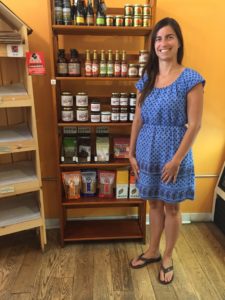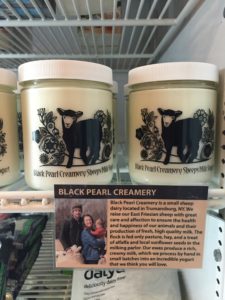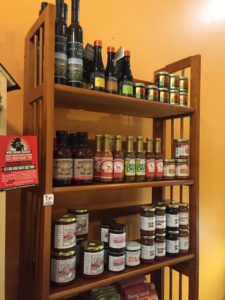Local Foods Movement is “Good to Go” in Trumansburg
Good to Go is a small grocery store/deli/bakery located in the heart of Downtown Trumansburg, New York. The store is quaint, with a small but dynamic offering of goods. I had the chance to sit down with Nana Monaco, one of the owners, and speak with her about how Good to Go works with local producers to sell their products.
by Carli Fraccarolli
The inspiration for Good to Go Grocery came not from Nana’s head, but from her stomach. Working for the Finger Lakes Grassroots Festival, she was sick of pizza every day and wanted someplace where she could get something quick and healthy. When a space opened up in downtown Trumansburg, Nana capitalized on the opportunity to build her vision. With a focus on healthy eating and familial connections to the local foods movement, it was easy for Nana to begin providing local goods. “[The local foods] movement is so vibrant in Trumansburg and we are fortunate to have so many local products available,” she says.

Nana Monaco stands in front of a shelf containing goods from the Finger Lakes area. Photo by Carli Fraccarolli
In order to start providing local goods, Nana first went to Regional Access, a food distributor in Ithaca, New York. Some producers do not or cannot distribute their products themselves, but Nana is able to order a wide variety of items through Regional Access. The nice thing about [working with] a distributor,” she says, “is being able to contact one source for multiple items”. It is easier and less time consuming to work with one vendor rather than paying and ordering individually.
Nana does, however, work directly with local producers. The variety and quantity of local foods have increased at Good to Go because people have visited the store to say, “Hey, I make this. Do you want to try it?” Nana has rarely turned down an opportunity to feature something local. “My rule is that I always say yes if it is someone local,” she says, although she admits not all local products do equally well. For Nana, the advantage of working directly with farmers is that it is typically cheaper because there is no middleman. This helps allow her to underprice the local goods she stocks to support the local businesses. Nana says she is willing to take cuts because she wants the local goods to be affordable for the customer and she wants the product to sell well for the producer.
When Nana agrees to work with a local producer, she does not implement formalities. “We don’t have a contract we use”, she says. “As small business owners I think we understand that we are not corporate and everyone has their different invoicing system, for example, or doesn’t have a system at all.” Every relationship is different depending on who is producing what. Nana might pay for something when it is delivered or 30 days later. Producers set up their own terms and she accommodates them.

Black Pearl Creamery Sheeps Milk Yogurt has a plaque dedicated to the description of the farm and a photo of the owners.
I ask Nana what she does to preserve the identity of farms whose products she sells, and she leads me to a shelf holding Black Pearl Creamery Sheep’s Milk Yogurt. There I see the small plaque with a photo of the farm and a description of their farming practices.
When she can, Nana creates short farm profiles like these to put next to the product, and tries to mark products with a “Locally Produced” label. She also has special shelves that display local products. These shelves help tourists and other customers identify what was produced in the Finger Lakes Region.
For small or midsize farmers looking to expand into small independent groceries, Nana had some advice. “It’s all about packaging and labeling and the way products look,” she says. “It really helps customers want to buy a product when they see packaging that is attractive and that represents the producer as a legitimate establishment”. Packaging is the first thing that customers see, so even if the product has a high quality taste, customers will judge the packaging before anything. From what Nana has experienced, customers want value-added products to be or taste homemade but don’t often like the products looking like they are homemade.

A shelf dedicated to a wide variety of locally produced foods stands near the front counter of the grocery.
Nana also spoke about case sizes for small establishments. If a producer has smaller case sizes, it makes it more tangible for a small retailer to actually buy. “Here,” says Nana, “we might not sell through something like yogurt as fast and I can’t afford to lose products and more money”. Nana has had producers offer to replace the product if it is getting low, or take back any product she doesn’t sell. This makes it easier for Nana to shelve products with shorter shelf lives.
Nana is willing to consider product from the greater Finger Lakes region. If you’re a farmer or producer interested in selling to the Good to Go Market, contact Nana directly or visit http://www.gtgtburg.com/. The best way to connect with Nana would be to stop into the store. Email and phone are other options, but most often the best way for a local producer to sell product is to bring in a sample.
Carli Fraccarolli is an undergraduate at Cornell University studying Environmental Science and Sustainability. She can be reached at cvf22@cornell.edu.

